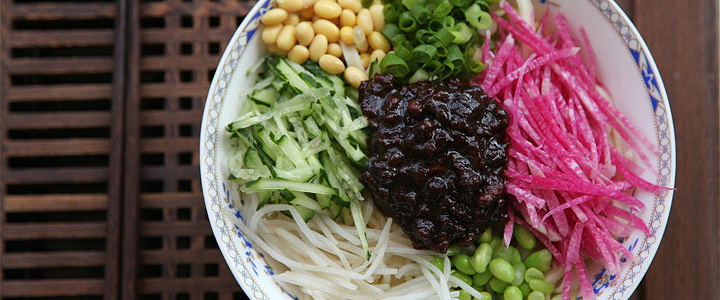
Top Must-Taste Foods in Beijing
Here are some of Beijing’s must-taste foods, which highlight the flavor of Beijing.
7 Classic Dishes in Beijing
Beijing Roast Duck(北京烤鸭)

Peking duck originated from Jinling duck of the Ming dynasty and can be traced back to the southern and northern dynasties. Beijing roast duck is a famous dish in Beijing with world reputation. It is made of high-quality meat duck, which is roasted on fruit wood charcoal fire. There are mainly two ways of roasting, braising oven and hanging oven. When eating, in addition to the traditional way of matching duck sauce and lotus leaf cake, there are also other 8 ways, including “Duck Skin Dipped in Sugar”.
Instant-boiled Mutton(涮羊肉)

Instant-boiled mutton is a Chinese hot pot dish. It has a history of more than 800 years and is one of Beijing’s most popular delicacies. Although both are instant-boiled meat, Beijing’s instant-boiled mutton and hot pot are very different, seasoning and copper pot are the essence of the old Beijing instant-boiled mutton. Among them, instant-boiled mutton seasoning is the key, and it usually includes sesame paste, leek flowers, fermented bean curd, chopped green onion, coriander and garlic, etc. The cookware of instant-boiled mutton is also distinctive, a hollow copper pot with charcoal fire in it. The local copper-pot instant-boiled mutton is especially popular in winter, when the food that warms body and stomach is especially suitable for the long cold winter in the north.
Noodles with Soybean Paste(炸酱面)

The essence of noodles with soybean paste in Beijing is on the fried soybean paste, which is made by stir-frying yellow soybean paste and diced meat(there is also maigre soybean paste made of eggs), seasoning with sliced cucumber, sliced summer radish, bean sprouts, green beans, beans, diced celery, etc. It is a favorite home-cooked dish in Beijing.
Douzhir/Fermented Soya-bean Milk(豆汁儿)

Douzhi is a fermented dish in Beijing cuisine. It is similar to soy milk, but made from mung beans. It is a by-product of cellophane noodle production. It is generally slightly sour, with an egg-like smell. Made from fermented mung bean residue, Douzhi is almost one of Beijing’s most famous snacks, not because it tastes good, but it’s hard to swallow. But the magic of this snack is that those who do not love it keep a distance from it, and those who love it, wish to have this snack every day. It is said that Douzhi has once entered the palace and became a royal snack. Not everyone in Beijing has tasted Douzhi, which is no longer as popular as in those days among Beijingers. But with its reputation, many travelers to Beijing are willing to give it a try.
Bittern Flapjack/Luzhu Huoshao(卤煮火烧)

Luzhu Huoshao/Bittern Flapjack, a native food of Beijing, is purer than Peking Opera. It literally means stewed baked wheaten cake, and unsuspecting diners may be surprised to find the baked wheaten cake floating in a steaming soup with pork small intestines, pig lungs, pig liver and tofu, etc. This may be enough to keep many visitors at a safe distance, but for Beijingers, this traditional local delicacy is a favorite, and a feast for those who want to refresh themselves after a long day at work or warm up on a cold winter day.
Chaogan/Stewed Pork Liver(炒肝儿)

Fried liver is a Chinese dish, especially famous in Beijing. Its history dates back to the Song dynasty (960 AD -1279 AD). It is basically made from pig liver and intestines, seasoned with garlic, bamboo shoots, celery, carrots and potato starch solution. It’s called Fried liver, but it is not cooked by frying, but boiling, so it’s actually really like a thick soup. This traditional street food in Beijing is a good choice for breakfast, usually served with steamed stuffed bun.
Baodu/Fried Beef Tripe(爆肚)

Cooked Beef or Sheep Tripe is a popular dish on Wangfujing snack street, where most restaurants selling cooked tripe are owned by Hui people. Making this delicious traditional street food in Beijing is simple. First, wash the fresh tripe, cut it into strips and cook it in boiling water. Usually, people dip them in various sauces, including oil, sesame paste, vinegar, chili, miso soup, coriander and chopped green onion, etc.











